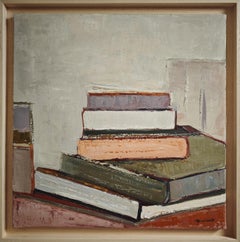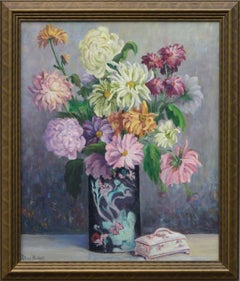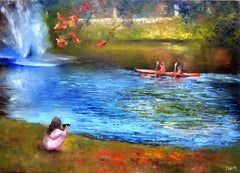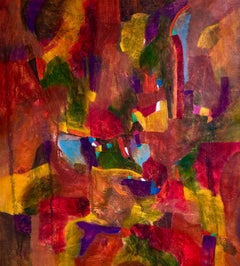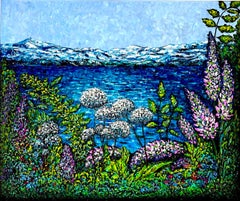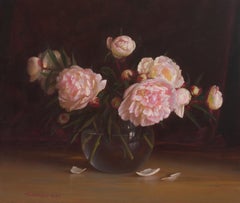Interior Paintings
2010s Abstract Interior Paintings
Cotton Canvas, Oil
2010s Abstract Interior Paintings
Canvas, Oil
2010s Abstract Impressionist Interior Paintings
Oil
2010s Expressionist Interior Paintings
Canvas, Oil
2010s Expressionist Interior Paintings
Canvas, Oil
2010s Realist Interior Paintings
Canvas, Oil
21st Century and Contemporary Contemporary Interior Paintings
Canvas, Oil, Acrylic
2010s Contemporary Interior Paintings
Gold Leaf
2010s Abstract Interior Paintings
Cotton Canvas, Oil
Artist Comments
A solitary house with deep blue doors anchors this peaceful, simplified landscape. The soft green field and crisp sky invite a moment of quiet reflection. The s...
21st Century and Contemporary Contemporary Interior Paintings
Acrylic
2010s Expressionist Interior Paintings
Canvas, Oil
2010s Contemporary Interior Paintings
Cotton Canvas, Oil
Mid-20th Century Dutch School Interior Paintings
Oil
Early 20th Century Realist Interior Paintings
Oil
Artist Comments
A ballerina balances en pointe on a rust-red steel girder suspended high above a pastel-hued cityscape. The image contrasts delicate grace with industrial stren...
21st Century and Contemporary Pop Art Interior Paintings
Oil
1650s Old Masters Interior Paintings
Oak, Oil, Wood Panel
Mid-20th Century Surrealist Interior Paintings
Canvas, Oil, Board, Graphite
2010s Abstract Interior Paintings
Cotton Canvas, Oil
1920s Modern Interior Paintings
Oil, Canvas
2010s Abstract Interior Paintings
Cotton Canvas, Oil
2010s Abstract Interior Paintings
Acrylic
Early 20th Century Post-Impressionist Interior Paintings
Oil
2010s Contemporary Interior Paintings
Canvas, Oil, Acrylic
2010s Contemporary Interior Paintings
Canvas, Acrylic
Artist Comments
A man sits alone in a pristine corner office, surrounded by glass walls framing a beguiling sea and a distant sailboat, emblematic of freedom and escape. Inside...
21st Century and Contemporary Contemporary Interior Paintings
Oil
20th Century Impressionist Interior Paintings
Oil
2010s Impressionist Interior Paintings
Acrylic, Canvas
2010s Contemporary Interior Paintings
Cotton Canvas, Oil, Acrylic, Charcoal, Pen
2010s Realist Interior Paintings
Canvas, Oil
Late 20th Century Post-Impressionist Interior Paintings
Watercolor
2010s Impressionist Interior Paintings
Canvas, Acrylic
Artist Comments
Sunlight filters through the dilapidated room, illuminating dust motes and peeling paint. Before the crumbling fireplace, the translucent figures of the home's ...
21st Century and Contemporary Contemporary Interior Paintings
Acrylic
1950s Modern Interior Paintings
Canvas, Oil
1890s Victorian Interior Paintings
Oil
2010s Contemporary Interior Paintings
Canvas, Oil
21st Century and Contemporary Contemporary Interior Paintings
Textile, Mixed Media, Canvas, Thread, Oil, Acrylic
Early 20th Century Post-Impressionist Interior Paintings
Oil
Early 20th Century English School Interior Paintings
Oil
Early 2000s Contemporary Interior Paintings
Canvas, Oil
21st Century and Contemporary Abstract Geometric Interior Paintings
Oil
Late 20th Century Feminist Interior Paintings
Oil
Mid-20th Century Post-Impressionist Interior Paintings
Oil
Late 20th Century Modern Interior Paintings
Oil
1860s Realist Interior Paintings
Oil
2010s Abstract Expressionist Interior Paintings
Canvas, Acrylic
Artist Comments
A woman sits on a bench, sipping her drink, outside of St. Mark’s Coffee & Tea in the East Village. The cafe’s red facade contrasts with the subdued urban e...
21st Century and Contemporary Realist Interior Paintings
Oil
18th Century Old Masters Interior Paintings
Oil, Canvas
21st Century and Contemporary Contemporary Interior Paintings
Canvas, Oil
2010s Impressionist Interior Paintings
Oil, Panel
Early 2000s Contemporary Interior Paintings
Canvas, Oil
Late 19th Century French School Interior Paintings
Oil
2010s Contemporary Interior Paintings
Canvas, Oil
Early 20th Century Post-Impressionist Interior Paintings
Oil, Canvas
Mid-20th Century Cubist Interior Paintings
Oil
19th Century Romantic Interior Paintings
Oil, Canvas
2010s Abstract Interior Paintings
Canvas, Spray Paint, Acrylic
2010s Impressionist Interior Paintings
Canvas, Acrylic
2010s Contemporary Interior Paintings
Canvas, Oil
2010s Realist Interior Paintings
Canvas, Oil
2010s Abstract Interior Paintings
Paper, Acrylic
